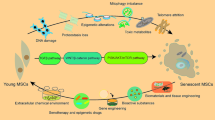Summary
In 48h incubation L-929 (L-5) cells secreted collagenous protein accounting for 16% of the total protein. CM-chromatography, SDS-acrylamide gel electrophoresis and DEAE-cellulose chromatography revealed that the collagenous protein was mainly composed of type I collagen, having no collagen of type III.
In addition, precursor-form collagen and tropocollagen molecules were found to be present in the incubate.
Zusammenfassung
L-929 (L-5) Mausfibroblasten synthetisieren bei einer 48-stündigen in vitro Inkubation kollagene Proteine mit einem Anteil von 16% am Gesamtprotein. Mit CM-Chromatographie, SDS-acrylamidgelelektrophorese und DEAE-Chromatographie wurde gezeigt, daß praktisch ausschließlich Typ I Kollagen synthetisiert wird, während Typ III Kollagen nicht nachweisbar ist. Zusätzlich fanden sich Kollagenvorläufer und Tropokollagen im Inkubationsmedium.
Similar content being viewed by others
References
Bailey, A. J., Bazin, S., Sims, T. J., LeLous, M., Nicoletis, C., Delaunay, A.: Characterization of the collagen of human hypertrophic and normal scars. Biochim. Biophys. Acta.405, 412–421 (1975)
Barnes, M. J., Morton, L. F., Bennet, R. C., Bailey, A. J., Sims, T. J.: Presence of type III collagen in guinea pig dermal scar. Biochem. J.157, 263–266 (1976)
Byers, P. H., McKenney, K. H., Lichtenstein, J. R., Martin, G. R.: Preparation of type III procollagen and collagen from rat skin. Biochemistry13, 5243–5248 (1974)
Chung, E., Miller, E. J.: Collagen polymorphism: characterization of molecules with the chain composition [α 1 (III)]3 in human tissues. Science183, 1200–1201 (1974)
Church, R. L., Tanzer, M. L., Lapiere, C. M.: Identification of two distinct species of procollagen synthesized by a clonal line of calf dermatosparactic cells. Nature New Biol.244, 188–190 (1973)
Deshmukh, K., Kline, W. G.: Characterization of collagen and its precursors synthesized by rabbit-articular-cartilage cells in various culture systems. Eur. J. Biochem.69, 117–123 (1976)
Eyre, D. R., Muir, H.: The type III collagen: A major constituent of rheumatoid and normal human synovial membrane. Conn. Tiss. Res.4, 11–16 (1975)
Fessler, L. I., Burgeson, R. E., Morris, N. P., Fessler, J. H.: Collagen synthesis: A disulfide-linked collagen precursor in chick bone. Proc. Nat. Acad. Sci.70, 2993–2996 (1973)
Gay, S., Müller, P. K., Meigel, W. N., Kühn, K.: Polymorphie des Kollagens. Neue Aspekte für Struktur und Funktion des Bindegewebes. Hautarzt27, 196–205 (1976)
Goldberg, B., Epstein, E. H., Sherr, C.: Precursors of collagen secreted by cultured human fibroblast. Proc. Nat. Acad. Sci.69, 3655–3659 (1972)
Gribble, T. J., Comstock, J. P., Udenfriend, S.: Collagen chain formation and peptidyl proline hydroxylation in monolayer tissue cultures of L-929 fibroblasts. Arch. Biochem. Biophys.129, 308–316 (1969)
Hayashi, T., Nagai, Y.: Separation ofα 1 (I) andα 1 (III) chain of collagen used by SDS-poly-acrylamide gel electrophoresis. Seikagaku48, 514 (1976)
Kerwar, S. S., Cardinale, G. J., Kohn, L. D., Spears, C. L., Stassen, F. L. H.: Cell-free synthesis of procollagen: L-929 fibroblasts as a cellular model for dermatosparaxis. Proc. Nat. Acad. Sci.70, 1378–1382 (1973)
Matsubayashi, S., Shinkai, H., Sano, S.: Biochemical characterization of connective tissue macromolecules derived from cutaneous fibrosarcoma. (in press)
Monson, J. M., Bornstein, P.: Identification of a disulfide-linked procollagen as the biosynthetic precursor of chick-bone collagen. Proc. Nat. Acad. Sci.70, 3521–3525 (1973)
Piez, K. A., Eigner, E. A., Lewis, M. S.: The chromatographic separation and amino acid composition of the subunits of several collagens. Biochemistry2, 58–66 (1963)
Rojkind, M., Martinez-Palmo, A.: Increase in type I and III collagens in human alcoholic liver cirrhosis. Proc. Nat. Acad. Sci.73, 539–543 (1976)
Smith, B. D., Byers, P. H., Martin, G. R.: Production of procollagen by human fibroblasts in culture. Proc. Nat. Acad. Sci.69, 3260–3262 (1972)
Uitto, J., Lichtenstein, J. R.: Defects in the biochemistry of collagen in diseases of connective tissue. J. invest. Derm.66, 59–79 (1976)
Weber, K., Osborn, M.: The reliability of molecular weight determinations by dodecyl sulfatepolyacrylamide gel electrophoresis. J. Biol. Chem.244, 4406–4412 (1969)
Author information
Authors and Affiliations
Additional information
Offprint requests to: Hiroshi Shinkai, M. D. (address see above)
Rights and permissions
About this article
Cite this article
Matsubayashi, S., Shinkai, H. & Sano, S. Characterization of the synthesized collagen by mouse L-929 (L-5) cells. Arch. Derm. Res. 260, 7–15 (1977). https://doi.org/10.1007/BF00558009
Received:
Issue Date:
DOI: https://doi.org/10.1007/BF00558009




